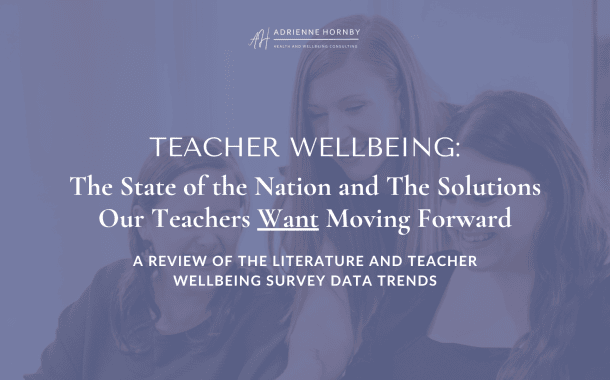
Why Staff Wellbeing Check-Ins are Essential for a Thriving, High-Performing School
Schools provide a sense of purpose and achievement for leaders, teachers and staff. However, various job-related stressors can increase the risk of mental health issues in Education. School leaders have a duty to ensure the wellbeing of their staff, and conducting regular staff and teacher wellbeing check-ins is one proactive approach that can create a supportive and caring work environment. Check-ins offer more than just a moment of conversation when done well. They contribute to a genuine culture of openness, trust and psychological safety where staff feel seen, heard and valued.
Of course, some leaders may feel hesitant about introducing staff wellbeing check-ins, concerned that they might feel tokenistic or that staff won’t open up. These are valid concerns, often stemming from previous experiences with superficial initiatives or low-trust environments. To overcome this, it is crucial to be transparent about the purpose of check-ins, positioning them as part of a broader, long-term commitment to teacher and staff wellbeing, not just a “tick-the-box” task. Leaders must follow through on feedback, create safe spaces for honest conversation and start small if needed by working with willing staff. When approached authentically and consistently, wellbeing check-ins can help rebuild trust, open meaningful dialogue and create a stronger, more supportive culture for everyone
This article covers:
- A look at the current state of mental health in education and why check-ins matter
- How staff wellbeing check-ins align with being a Well-Led School
- The benefits of wellbeing check-ins
- Practical methods for checking in with staff
The Current State of Mental Health in Education and Why Wellbeing Check-Ins Matter
The 2024 National Mental Health in Education Survey conducted by Be You found that 62% of educators feel their leadership actively supports staff and teacher wellbeing. However, only 54% of educators have access to dedicated wellbeing coordinators. The report also highlights key barriers to educator wellbeing, including staff turnover and shortages, lack of time and resources and a lack of preparedness to provide support after a critical incident.
Another study by the Australian Council for Educational Research (ACER) found that 54% of teachers reported moderate to severe symptoms of depression, while 46% experienced anxiety.
Further, our surveys of Australian schools showed that, on average:
- 33% of staff disagree when asked if they feel well mentally and/or emotionally
- 42% of staff agree when asked if they feel burned out most days
- 41% of staff disagree when asked if their work has a positive impact on their wellbeing
- 46% of staff agree they are encouraged to speak openly about their mental health and wellbeing
These findings paint a clear picture: while there is growing recognition of the importance of staff and teacher wellbeing, significant gaps remain in the support available to educators. High rates of burnout, mental health challenges and feelings of disconnection from meaningful impact are concerning trends that cannot be ignored.
In this environment, leaders play a crucial role. Regular, meaningful check-ins are not just a nice-to-have, they are a practical, necessary strategy to help educators feel heard, valued and supported. Check-ins offer an opportunity to identify issues early, strengthen trust and create a culture where mental health and wellbeing are actively prioritised, not just passively acknowledged.
The Benefits of Staff Wellbeing Check-Ins
Regular staff and teacher wellbeing check-ins are a supportive gesture and a powerful way to build a thriving and resilient school community. Here’s how they make a difference:
- Fostering a culture of openness and support: Regular check-ins send a clear message that staff mental health is a priority. Over time, they help normalise conversations about wellbeing, building a school culture rooted in trust, empathy and support. Staff are more likely to seek help when they know they won’t be judged or overlooked.
- Early detection of issues: Checking in consistently creates opportunities to notice early signs of stress, burnout or mental health challenges before they escalate. Leaders can provide timely support, connect staff with appropriate resources, or adjust workloads as needed, preventing small issues from becoming major crises.
- Improving staff engagement and productivity: When staff feel genuinely supported and valued, their commitment to their work strengthens. Regular check-ins demonstrate that leadership prioritises their wellbeing, leading to higher morale, greater job satisfaction and ultimately improved productivity and engagement in their roles.
- Reducing the stigma surrounding mental health: By creating safe spaces for open discussions about mental health, check-ins help break down lingering stigma. Staff come to understand that mental health struggles are not a weakness, but a natural part of life that can and should be addressed with support and care.
- Enhancing retention and recruitment: Schools that weave wellbeing into their culture are more attractive to current and prospective staff. Educators want to work and stay in environments where their wellbeing is genuinely prioritised, not just spoken about. Wellbeing check-ins are a visible, tangible sign that the school ‘walks the walk’
In short, staff and teacher wellbeing check-ins are a simple but highly effective practice that strengthens individuals, teams and the wider school community. When wellbeing is nurtured through consistent, authentic connection, everyone benefits, especially the students we serve and support.
Practical Methods for Checking in with Staff
Effective staff wellbeing check-ins don’t have to be complicated or time-consuming. What matters most is creating regular opportunities for genuine, supportive conversations. Here are some practical methods you can use to build connection, trust and a culture of care.
1. Regular One-on-One Check-ins
These individual meetings create space for staff to share concerns, celebrate successes, and discuss any challenges they are facing. Scheduling these regularly (e.g., every 2-4 weeks) helps ensure consistency.
Sample agenda:
- Positive opening (2-3 minutes)
- Review recent accomplishments (5 minutes)
- Discuss current projects/challenges (10 minutes)
- Set goals for the next period (5 minutes)
- Gather feedback/support requests (5 minutes)
Sample questions:
- “What’s been your biggest win recently?”
- “What’s your top priority right now, and are there any obstacles I can help with?”
- “How can I better support you?”
2. Have a “Stop-Reflect-Act“conversation with staff:
These chats provide a structured process for school leaders or colleagues to check in on someone’s wellbeing while ensuring the conversation remains constructive and empathetic. Here’s how it applies in a mental health context:
- STOP: Make time to ask the person how they are doing. Pause and listen
- REFLECT: Providing emotional support is about being willing to talk about what is going on, how the person/group feels, and their options for support. If there are concerns: consider timing, space, policies, and professional boundaries before acting
- ACT – Acknowledge feelings and experiences, offer practical support, encourage self-care and professional support, follow up and through
3. “Fireside Chats”
“Fireside” chats are informal, open discussions designed to foster a relaxed, open environment. These gatherings help break down barriers and encourage honest conversations about wellbeing.
Considerations:
- Choose a comfortable location
- Set clear objectives for the chat (e.g., sharing experiences, discussing a specific topic)
- Follow up with a summary or resources afterwards
4. Hold a Mental Health First Aid Conversation Using the ALGEE Method
The ALGEE method from Mental Health First Aid provides a structured approach to having conversations about mental health and offering support when someone may be experiencing a mental health challenge.
- A – Approach, Assess, and Assist
Gently approach the person, assess their wellbeing, and offer help. Look for warning signs of distress. - L – Listen Non-Judgmentally
Listen actively and without judgment. Allow them to share their feelings and experiences without interruption. - G – Give Support and Information
Provide reassurance and helpful information. Let them know that mental health challenges are common and treatable. - E – Encourage Professional Help
Suggest seeking professional support, like a counsellor or therapist, if necessary. - E – Encourage Self-Help
Promote self-care and other support strategies, such as exercise, mindfulness, or talking to friends and family.
5. Team Huddles
A team huddle is a short, informal meeting where staff come together to share updates, align on priorities, and address challenges. These can be held daily, weekly or a few times a term.
Sample Structure:
- Quick individual check-ins (30 seconds per person)
- Celebrate recent wins
- Review top priorities
- Address team-wide challenges or announcements
6. Pulse Surveys
Pulse surveys are brief, frequent surveys designed to gauge staff sentiment. They provide a regular snapshot of staff wellbeing and engagement.
Example Questions:
- On a scale of 1-5, how supported do you feel in your role this week?
- What’s one thing that could improve your work experience right now?
- Do you have the resources you need to achieve your goals?
We recommend Pulse Surveys from High Performance Teams
7. Open-Door Policy
Establish specific times when staff can drop by for informal conversations. This signals to staff that leadership is approachable and that their concerns will be heard.
IMPORTANT: Your staff need to know there is an open door policy in place, how to access you, and for what purpose for it to be truly effective.
Script for introducing an Open-Door Policy:
“I want to make sure I’m accessible to all of you. Every Tuesday and Thursday from 3-4 PM, my door will be open for anyone who wants to chat, share ideas, or discuss concerns. No appointment necessary.”
8. Wellbeing Champions
Assign staff members as ‘Wellbeing Champions’ who act as an informal point of contact for colleagues. This peer support can foster a more supportive environment.
How to implement:
- Appoint 1-2 staff as Wellbeing Champions
- Set up protocols to check in informally with staff and report any concerns to leadership.
By implementing these practical ideas, school leaders can foster a healthier, more supportive work environment, encourage open dialogue, and prioritise staff wellbeing, leading to improved morale and retention.
Free PDF Resource Download
Download a PDF Version of this Check-In Guide
Conclusion
At their core, staff and teacher wellbeing check-ins are about valuing people as much as performance. They strengthen trust, uncover challenges early, foster a culture of openness and help normalise conversations around mental health. Most importantly, they show that your school doesn’t just talk about wellbeing, it actively invests in it. By making regular check-ins a standard leadership practice, schools can create healthier, happier and more resilient communities where both staff and students thrive.
If your school is ready to take a deeper, more strategic approach to staff wellbeing, I invite you to explore the Well-Led Schools Partnership Program. Through tailored support, resources and expert guidance, we help schools embed the 9 Guiding Principles of Well-led Schools into everyday practice, ensuring initiatives like staff wellbeing check-ins are meaningful, sustainable and transformative. Discover how we can support your school’s journey here.
Resources
- Access our suite of Mental Health and Wellbeing Resources for the Workplace
- Employee Wellbeing Check-In Guide
- Workplace Mental Health Resource
- The Importance of Mental Health Check-Ins
Support Agencies and Organisations
- Support Act Wellbeing Helpline – The Helpline is a free, confidential phone counselling service available to anyone anywhere in Australia who works in the arts and culture sector. It can be easily accessed by calling 1800 959 500.
- Mentally Healthy Workplaces – Produced by the National Workplace Initiative, the Mentally Healthy Workplaces digital platform provides simple, consistent, quality-assured advice in one place
- Black Dog Institute – The Black Dog Institute provides workplace resources and training, including a mental health toolkit for leaders, offering a practical guide to break down the stigma of mental illness and foster a work environment that promotes wellbeing.
- Mental Health First Aid – Offering training recognised for lessening the impact of mental health problems on productivity, Mental Health First Aid can provide the foundation for a workplace mental health strategy.
- Head to Health – The Head to Health website can help you find digital mental health services from some of Australia’s most trusted mental health organisations.
From the blog
Optimising School Workload with Practical Tips and Resources from the AITSL Workload Reduction Toolkit
Ask any teacher or school leader about their biggest source of stress, and you’ll likely hear the same answer: workload. Evidence indicates that school leaders…
Teacher Wellbeing: The State of the Nation and The Solutions Our Teachers Want Moving Forward
Teacher wellbeing is not just a personal issue; it’s a professional necessity. It’s closely tied to educator success and student outcomes, and a lack of…
Staff Morale in Schools: How Culture, Leadership and Staff Drive Engagement
If you’ve been leading or working in a school over the past few years, you’ve probably felt it – the subtle, steady dip in energy,…



